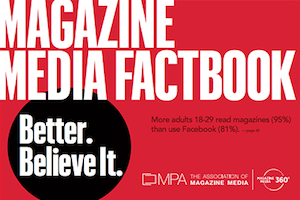The top 50 U.S. marketers spent slightly more than $6.1 billion on print magazine advertising last year, which represents a decline of more than $417 million from 2016’s $6.52 billion and about $450 million less than 2015’s $6.56 billion, according to analysis released by magazine industry trade group The Association of Magazine Media.
The MPA’s annual Factbook report, which measures magazine audiences and readership engagement habits, tallied 7,176 U.S. consumer print magazines in 2017, which represents a loss of more than 200 titles from 2008’s 7,383.
 |
Despite this, 766 new magazines, special editions and “bookazines” still managed to debut last year — about 130 of them consumer magazines — and several key findings in MPA’s 2018/19 Factbook research suggest that while ad counts might be down, magazine media continues to be a more trusted and influential platform than competing media sources.
While trust in search engines and social media platforms has declined by about two percent in the last year, the report found that consumer trust in traditional and online media journalism has rebounded, up five percent since last year.
Surprisingly, the report also found that a higher percentage of U.S. adults ages 18–29 (95 percent) now read magazines than they use Facebook (81 percent). U.S. magazine reader audiences also remain diverse, tend to immerse themselves in magazines more deeply than other media, and adult audiences say ads featured in magazines also tended to engage them more than ads in competing formats. Magazines advertising campaigns particularly boost brand awareness when it comes to prescription drug brands and beauty products.
The report also revealed that magazine media brands remain incredibly influential when it comes to social media engagement compared to non-magazine media brands. Finally, magazines also tend to attract affluent audiences, as the Factbook report found that households earning annual incomes of more than $250,000 are particularly drawn to print magazines, with this medium reaching more affluent consumers than the Internet, newspapers, radio and TV and across more categories.


 Abandon traditional content plans focused on a linear buyer progression and instead embrace a consumer journey where no matter which direction they travel, they get what they need, stressed marketing pro Ashley Faus during O'Dwyer's webinar Apr. 2.
Abandon traditional content plans focused on a linear buyer progression and instead embrace a consumer journey where no matter which direction they travel, they get what they need, stressed marketing pro Ashley Faus during O'Dwyer's webinar Apr. 2. Freelance marketers and the companies that hire them are both satisfied with the current work arrangements they have and anticipate the volume of freelance opportunities to increase in the future, according to new data on the growing freelance marketing economy.
Freelance marketers and the companies that hire them are both satisfied with the current work arrangements they have and anticipate the volume of freelance opportunities to increase in the future, according to new data on the growing freelance marketing economy. Home Depot's new attempt to occupy two market positions at once will require careful positioning strategy and execution to make it work.
Home Depot's new attempt to occupy two market positions at once will require careful positioning strategy and execution to make it work. Verizon snags Peloton Interactive chief marketing officer Leslie Berland as its new CMO, effective Jan. 9. Berland succeeds Diego Scotti, who left Verizon earlier this year.
Verizon snags Peloton Interactive chief marketing officer Leslie Berland as its new CMO, effective Jan. 9. Berland succeeds Diego Scotti, who left Verizon earlier this year.  Norm de Greve, who has been CMO at CVS Health since 2015, is taking the top marketing job at General Motors, effective July 31.
Norm de Greve, who has been CMO at CVS Health since 2015, is taking the top marketing job at General Motors, effective July 31.


 Have a comment? Send it to
Have a comment? Send it to 
No comments have been submitted for this story yet.